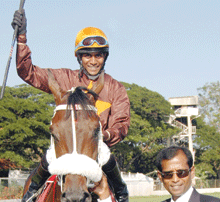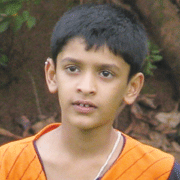 One of the most consistent first-past-the-post jockeys on the Indian horseracing circuit is Suraj Narredu (26) who rode Becket, owned by Haresh N. Mehta, to victory in the Nizam’s Gold Cup at Hyderabad last August, a landmark win which establ-ished him as the youngest Indian jockey to record 1,000 wins. “Now I have set myself higher goals to race only in top grade and classic races,” says this diminutive (5 ft 6") 50 kg jockey, who began his professional career as an apprentice at the Bangalore Turf Club in 2002.
One of the most consistent first-past-the-post jockeys on the Indian horseracing circuit is Suraj Narredu (26) who rode Becket, owned by Haresh N. Mehta, to victory in the Nizam’s Gold Cup at Hyderabad last August, a landmark win which establ-ished him as the youngest Indian jockey to record 1,000 wins. “Now I have set myself higher goals to race only in top grade and classic races,” says this diminutive (5 ft 6") 50 kg jockey, who began his professional career as an apprentice at the Bangalore Turf Club in 2002.
With his father Satish and uncle Malesh both professional jockeys and also members of the dozen-strong 1,000 wins club, love of the sound of hoofbeats and equines came naturally to Suraj, and gradually developed into a passion for horseracing. “As an apprentice jockey in early 2002 when I didn’t win a race for three months, I was about to quit horseracing. But I hung in there for a while and went on to win 40 races during the next seven months which made me eligible for a professional (jockey’s) licence,” recalls Suraj.
According to him, aspiring jockeys are required to work for three years under a horse trainer before qualifying for an apprentice licence. Forty wins or attaining 25 years of age, whichever is earlier, is the eligibility criterion for a professional licence. Subsequently the route to the top is a retainer from an owner and 7.5 percent of prize money, explains Suraj. After qualifying as a professional jockey in July 2002 at the age of 17, he began his career in the southern racing hubs of Bangalore, Mysore and Hyderabad.
Since then, there’s been no looking back for this talented horse whisperer who has attracted the attention of racehorse breeders and owners as far afield as Malaysia, Macau and Dubai with his biggest win being in the Rs.60 lakh GR1 Indian Turf Invitation Cup in March 2010 in Mumbai.
Vaulting into the 1,000 wins club at an early age, Suraj has now set his sights on chasing the 2,030 wins record of the Chennai-based jockey B. Prakash and Pesi Shroff’s 1,760 wins. And to acquire that extra edge, he is keen about taking on compet-ition in race courses abroad. “Getting into the 1,000 wins club is easier than attaining the next milestone. It requires extreme fitness — I train in the gym and with horses for three-four hours every day to maintain my weight below the 50 kg threshold. But I believe that if I can get a two-month permit to race in the US, I will acquire the international racing experience needed to rise to the next level. Unfortunately it’s not as easy for Indian jockeys to race abroad as it is for foreign jockeys to race in India. But I am working on it,” says Suraj.
Another milestone will no doubt soon flash by.
Paromita Sengupta (Bangalore)
Viraj Gapchoop
 With every religious occasion resulting in accumulation of mounds of flowers, garlands, paper and other festive runoff (aka nirmalya in Maharashtra), which ultimately finds its way into the city’s rivers and lakes and harms their ecosystems, 13-year-old Viraj Gapchoop, a class VIII student of the Jnana Prabodhini School, Nigdi (Pune), felt obliged to address the issue of environmental responsibility. The outcome of his cerebration is a four-minute documentary titled Wake Up, suggesting ways and means by which nirmalya can be recycled. Viraj’s documentary was among the collection of 110 films and documentaries from 36 cities countrywide selected for screening at Pune’s Vasundhara International Film Festival held in February.
With every religious occasion resulting in accumulation of mounds of flowers, garlands, paper and other festive runoff (aka nirmalya in Maharashtra), which ultimately finds its way into the city’s rivers and lakes and harms their ecosystems, 13-year-old Viraj Gapchoop, a class VIII student of the Jnana Prabodhini School, Nigdi (Pune), felt obliged to address the issue of environmental responsibility. The outcome of his cerebration is a four-minute documentary titled Wake Up, suggesting ways and means by which nirmalya can be recycled. Viraj’s documentary was among the collection of 110 films and documentaries from 36 cities countrywide selected for screening at Pune’s Vasundhara International Film Festival held in February.
“The idea came to me after watching people throw nirmalya from over the bridge into the Pavana river near my home. I did some basic research on the internet to find out whether such waste could be recycled instead of being dumped in lakes and rivers, and stumbled upon vermi-composting — a process of breaking down waste matter using worms and fungi to yield soil manure — as an economical waste disposal alternative. To spread public awareness about this method of reducing neighbourhood pollution, I decided to produce and direct Wake Up. It was shot over three weeks last year with a handycam and edited on my laptop,” says Viraj.
This is not his sole ecology initiative. In November 2009, he won an entry into the India Book of Records and Limca Book of Records for designing a semi-automatic water pump controller for effective usage of water. “It’s a simple instrument that controls the flow of water so that you use only as much as is needed,” says Viraj, who has applied to patent the semi-conductor driven water pump controller.
Viraj’s architect father Dinesh has been actively supporting his son’s interest in water-saving and green initiatives. “I give him advice without becoming involved in his projects. I believe that supplementary home learning not by way of tuitions but intelligent conversation on technology and scientific breakthroughs is also education,” says Dinesh Gapchoop.
Young and ever ready to speak up on environment issues, Viraj is set on making a career in photography and films. “These are very powerful media, effective in building global networks of people committed to making our planet a better place for all life forms,” says Viraj.
Wind in your sails!
Huned Contractor (Pune)